

Compact Muon Solenoid
LHC, CERN
| CMS-PAS-EXO-14-016 | ||
| MUSiC, a Model Unspecific Search for New Physics, in pp Collisions at $ \sqrt{s}= $ 8 TeV | ||
| CMS Collaboration | ||
| March 2017 | ||
| Abstract: This analysis summary presents the results of the Model Unspecific Search in CMS (MUSiC) based on data taken by the CMS detector at the LHC at a proton-proton center of mass energy of $\sqrt{s}= $ 8 TeV. Based on comparisons to standard model (SM) simulations, this search for unexpected new physics covers a wide array of final states with minimal theoretical bias. Events collected with electron and muon triggers are sorted into classes based on their final state topology, taking electrons, muons, photons, jets and missing transverse energy into account. For the analyzed data corresponding to about 20 fb$^{-1}$, this results in more than 200 event classes. The automated search algorithm subsequently surveys kinematic distributions of the data for deviations from the SM expectations, calculating a statistical significance. The sensitivity of the analysis is validated by surveying simulations of hypothetical models and by omitting known SM processes from the simulation. No indication of new physics has been found in the analyzed data. For a wide range of final state topologies, good agreement is found between the data and Monte Carlo based SM simulation. | ||
| Links: CDS record (PDF) ; inSPIRE record ; CADI line (restricted) ; | ||
| Figures | |

png pdf |
Figure 1:
Classification of a single event (red rectangle) containing one electron, two muons and one jet. This event will contribute to precisely one exclusive (green), several inclusive (blue) and jet-inclusive (orange) event classes. |

png pdf |
Figure 2:
The 50 most significant exclusive event classes, considering only the total number of events. |

png pdf |
Figure 3:
The 50 most significant inclusive event classes, considering only the total number of events. |
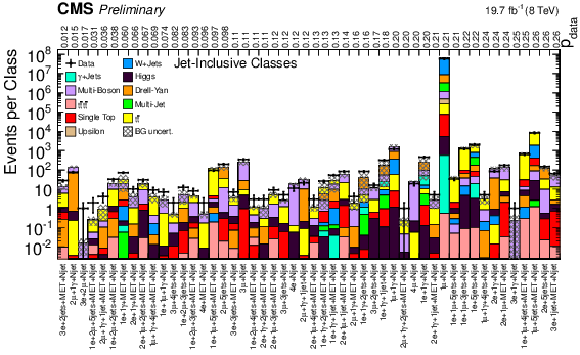
png pdf |
Figure 4:
The 50 most significant jet-inclusive event classes, considering only the total number of events. |

png pdf |
Figure 5:
Distribution of $p$-value for exclusive event classes in the scan of total event yield. Black markers represent the measured data compared to the SM MC expectation. The histogram labeled "MC vs. MC" represents the comparison of the SM MC expectation to pseudo-data generated under the SM-only hypothesis. As a further comparison, the expectation from the uniform distribution is given, where the individual components are explained in Sec. 3.5. In the first bin 148 distributions are observed, with 139$^{+4}_{-5}$ (1$\sigma $) $^{+\ 9}_{-10}$ (2$\sigma $) expected from the SM. |
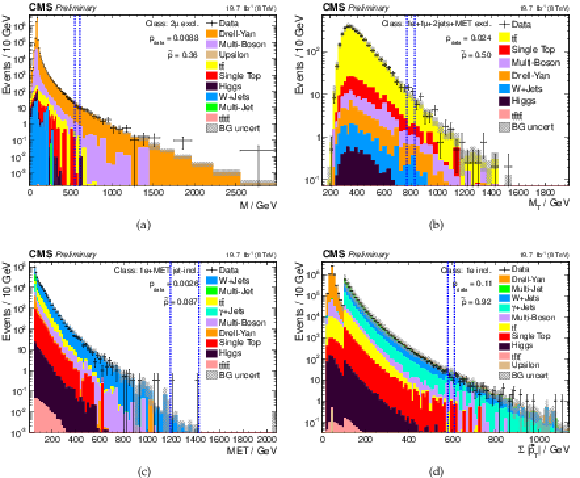
png pdf |
Figure 6:
Example results of the MUSiC scan of kinematic distributions. In each case, the region of interest (RoI) is depicted by blue dashed lines. The corresponding $p$-value ($p_{\text {data}}$) and LEE corrected $p$-value ($ \tilde{p} $) are given next to the legend under the event class name. No significant deviation is found in any of the shown classes and distributions: a) invariant mass spectrum in the exclusive 2$\mu$ event class; b) ${M_{T}}$ distribution of the exclusive event class 1e +1$\mu$ +2jets+MET ; c) MET distribution for the jet-inclusive event class in 1e +MET+Njet; d) ${\sum | \vec{p}_{\mathrm{T}} |} $ distribution of the inclusive 1e +X class. |

png pdf |
Figure 6-a:
MUSiC scan of the invariant mass spectrum in the exclusive 2$\mu$ event class.The region of interest (RoI) is depicted by blue dashed lines. The corresponding $p$-value ($p_{\text {data}}$) and LEE corrected $p$-value ($ \tilde{p} $) are given next to the legend under the event class name. No significant deviation is found. |

png pdf |
Figure 6-b:
MUSiC scan of the ${M_{T}}$ distribution of the exclusive event class 1e +1$\mu$ +2jets+MET. The region of interest (RoI) is depicted by blue dashed lines. The corresponding $p$-value ($p_{\text {data}}$) and LEE corrected $p$-value ($ \tilde{p} $) are given next to the legend under the event class name. No significant deviation is found. |
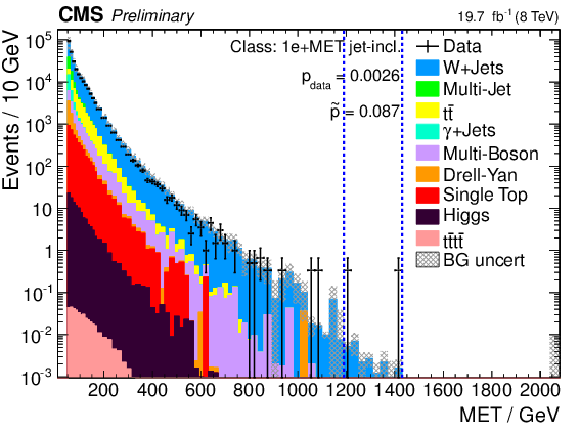
png pdf |
Figure 6-c:
MUSiC scan of the MET distribution for the jet-inclusive event class in 1e +MET+Njet. The region of interest (RoI) is depicted by blue dashed lines. The corresponding $p$-value ($p_{\text {data}}$) and LEE corrected $p$-value ($ \tilde{p} $) are given next to the legend under the event class name. No significant deviation is found. |
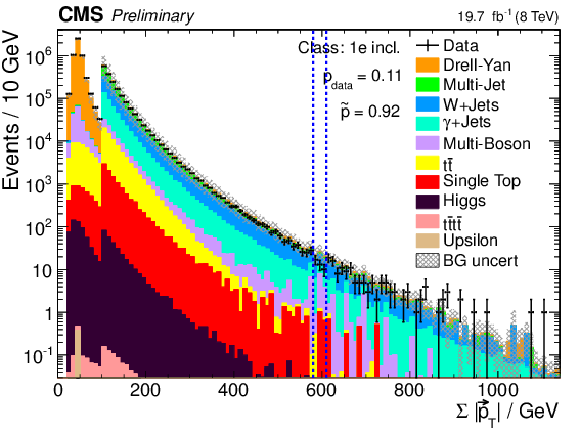
png pdf |
Figure 6-d:
MUSiC scan of the ${\sum | \vec{p}_{\mathrm{T}} |} $ distribution of the inclusive 1e +X class. The region of interest (RoI) is depicted by blue dashed lines. The corresponding $p$-value ($p_{\text {data}}$) and LEE corrected $p$-value ($ \tilde{p} $) are given next to the legend under the event class name. No significant deviation is found. |
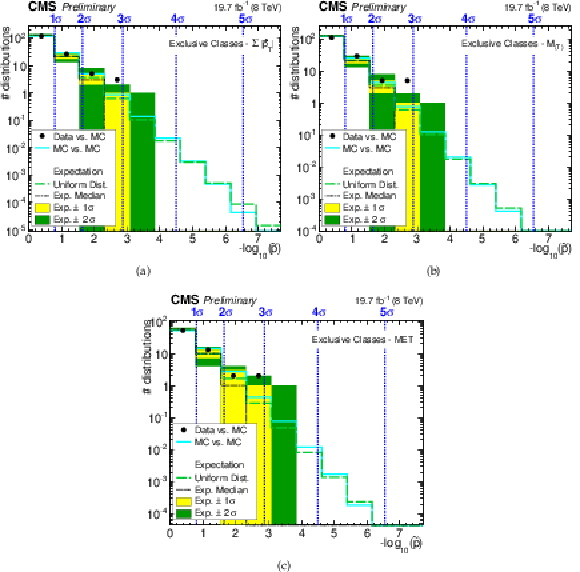
png pdf |
Figure 7:
Distribution of $\tilde{p}$-values for a scan of exclusive event classes in the three kinematic variables: (a) ${\sum | \vec{p}_{\mathrm{T}} |} $, (b) ${M_{(T)}}$ and (c) MET. Black markers represent the measured data compared to the SM MC expectation. The histogram labeled "MC vs. MC" represents the comparison of the SM MC expectation to pseudo-data generated under the SM-only hypothesis. As a further comparison, the expectation from the uniform distribution is given, where the individual components are explained in Sec. 3.5. Up to 2 10$^{6}$ pseudo-experiments were generated for each event class, allowing $ \tilde{p} $ values of up to 5$\sigma $ to be assessed. |

png pdf |
Figure 7-a:
Distribution of $\tilde{p}$-values for a scan of exclusive event classes in the ${\sum | \vec{p}_{\mathrm{T}} |} $ variable. Black markers represent the measured data compared to the SM MC expectation. The histogram labeled "MC vs. MC" represents the comparison of the SM MC expectation to pseudo-data generated under the SM-only hypothesis. As a further comparison, the expectation from the uniform distribution is given, where the individual components are explained in Sec. 3.5. Up to 2 10$^{6}$ pseudo-experiments were generated for each event class, allowing $ \tilde{p} $ values of up to 5$\sigma $ to be assessed. |
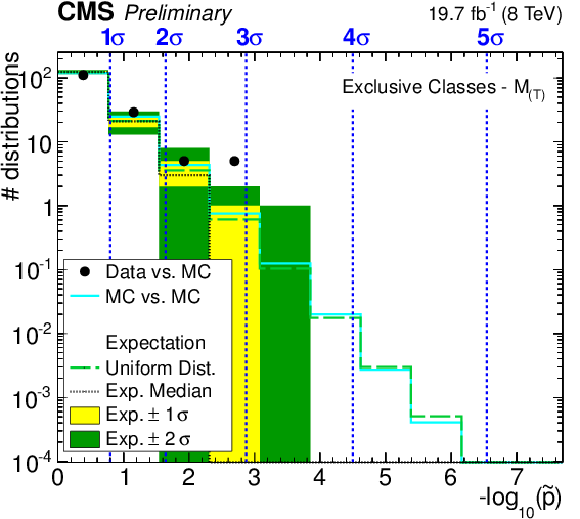
png pdf |
Figure 7-b:
Distribution of $\tilde{p}$-values for a scan of exclusive event classes in the ${M_{(T)}}$ variable. Black markers represent the measured data compared to the SM MC expectation. The histogram labeled "MC vs. MC" represents the comparison of the SM MC expectation to pseudo-data generated under the SM-only hypothesis. As a further comparison, the expectation from the uniform distribution is given, where the individual components are explained in Sec. 3.5. Up to 2 10$^{6}$ pseudo-experiments were generated for each event class, allowing $ \tilde{p} $ values of up to 5$\sigma $ to be assessed. |
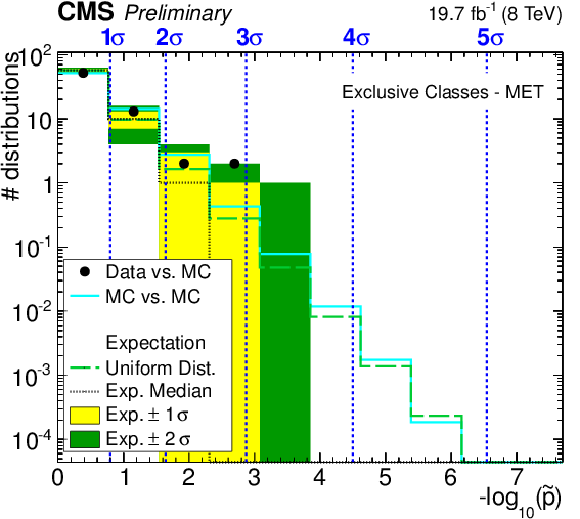
png pdf |
Figure 7-c:
Distribution of $\tilde{p}$-values for a scan of exclusive event classes in the MET variable. Black markers represent the measured data compared to the SM MC expectation. The histogram labeled "MC vs. MC" represents the comparison of the SM MC expectation to pseudo-data generated under the SM-only hypothesis. As a further comparison, the expectation from the uniform distribution is given, where the individual components are explained in Sec. 3.5. Up to 2 10$^{6}$ pseudo-experiments were generated for each event class, allowing $ \tilde{p} $ values of up to 5$\sigma $ to be assessed. |

png pdf |
Figure 8:
Distribution of $\tilde{p}$-values for a scan of inclusive event classes in the three kinematic variables: (a) ${\sum | \vec{p}_{\mathrm{T}} |} $, (b) $ {M_{(T)}} $ and (c) MET. Black markers represent the measured data compared to the SM MC expectation. The histogram labeled "MC vs. MC" represents the comparison of the SM MC expectation to pseudo-data generated under the SM-only hypothesis. As a further comparison, the expectation from the uniform distribution is given, where the individual components are explained in Sec. 3.5. Up to 2 10$^{-6}$ pseudo-experiments were generated for each event class, allowing $ \tilde{p} $ values of up to 5$\sigma $ to be assessed. |

png pdf |
Figure 8-a:
Distribution of $\tilde{p}$-values for a scan of inclusive event classes in the MET variable. Black markers represent the measured data compared to the SM MC expectation. The histogram labeled "MC vs. MC" represents the comparison of the SM MC expectation to pseudo-data generated under the SM-only hypothesis. As a further comparison, the expectation from the uniform distribution is given, where the individual components are explained in Sec. 3.5. Up to 2 10$^{-6}$ pseudo-experiments were generated for each event class, allowing $ \tilde{p} $ values of up to 5$\sigma $ to be assessed. |
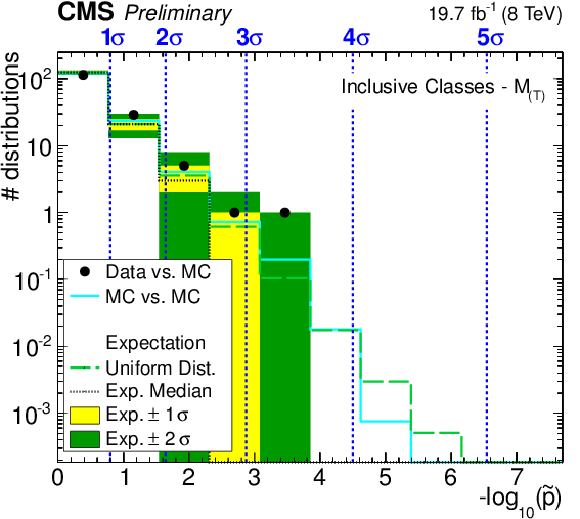
png pdf |
Figure 8-b:
Distribution of $\tilde{p}$-values for a scan of inclusive event classes in the three kinematic variables: (a) ${\sum | \vec{p}_{\mathrm{T}} |} $, (b) $ {M_{(T)}} $ and (c) MET. Black markers represent the measured data compared to the SM MC expectation. The histogram labeled "MC vs. MC" represents the comparison of the SM MC expectation to pseudo-data generated under the SM-only hypothesis. As a further comparison, the expectation from the uniform distribution is given, where the individual components are explained in Sec. 3.5. Up to 2 10$^{-6}$ pseudo-experiments were generated for each event class, allowing $ \tilde{p} $ values of up to 5$\sigma $ to be assessed. |

png pdf |
Figure 8-c:
Distribution of $\tilde{p}$-values for a scan of inclusive event classes in the three kinematic variables: (a) ${\sum | \vec{p}_{\mathrm{T}} |} $, (b) $ {M_{(T)}} $ and (c) MET. Black markers represent the measured data compared to the SM MC expectation. The histogram labeled "MC vs. MC" represents the comparison of the SM MC expectation to pseudo-data generated under the SM-only hypothesis. As a further comparison, the expectation from the uniform distribution is given, where the individual components are explained in Sec. 3.5. Up to 2 10$^{-6}$ pseudo-experiments were generated for each event class, allowing $ \tilde{p} $ values of up to 5$\sigma $ to be assessed. |
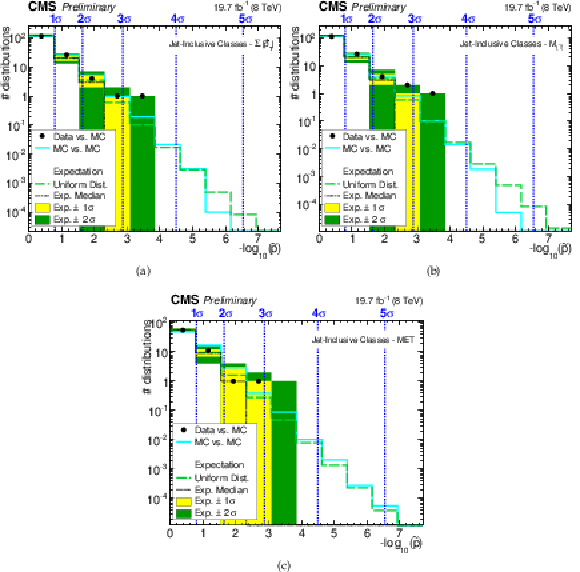
png pdf |
Figure 9:
Distribution of $\tilde{p}$-values for a scan of jet-inclusive event classes in the three kinematic variables: (a) ${\sum | \vec{p}_{\mathrm{T}} |} $, (b) $ {M_{(T)}} $ and (c) MET. Black markers represent the measured data compared to the SM MC expectation. The histogram labeled "MC vs. MC" represents the comparison of the SM MC expectation to pseudo-data generated under the SM-only hypothesis. As a further comparison, the expectation from the uniform distribution is given, where the individual components are explained in Sec. 3.5. Up to 2 10$^{-6}$ pseudo-experiments were generated for each event class, allowing $ \tilde{p} $ values of up to 5$\sigma $ to be assessed. |

png pdf |
Figure 9-a:
Distribution of $\tilde{p}$-values for a scan of jet-inclusive event classes in the ${\sum | \vec{p}_{\mathrm{T}} |} $ variable. Black markers represent the measured data compared to the SM MC expectation. The histogram labeled "MC vs. MC" represents the comparison of the SM MC expectation to pseudo-data generated under the SM-only hypothesis. As a further comparison, the expectation from the uniform distribution is given, where the individual components are explained in Sec. 3.5. Up to 2 10$^{-6}$ pseudo-experiments were generated for each event class, allowing $ \tilde{p} $ values of up to 5$\sigma $ to be assessed. |

png pdf |
Figure 9-b:
Distribution of $\tilde{p}$-values for a scan of jet-inclusive event classes in the $ {M_{(T)}} $ variable. Black markers represent the measured data compared to the SM MC expectation. The histogram labeled "MC vs. MC" represents the comparison of the SM MC expectation to pseudo-data generated under the SM-only hypothesis. As a further comparison, the expectation from the uniform distribution is given, where the individual components are explained in Sec. 3.5. Up to 2 10$^{-6}$ pseudo-experiments were generated for each event class, allowing $ \tilde{p} $ values of up to 5$\sigma $ to be assessed. |
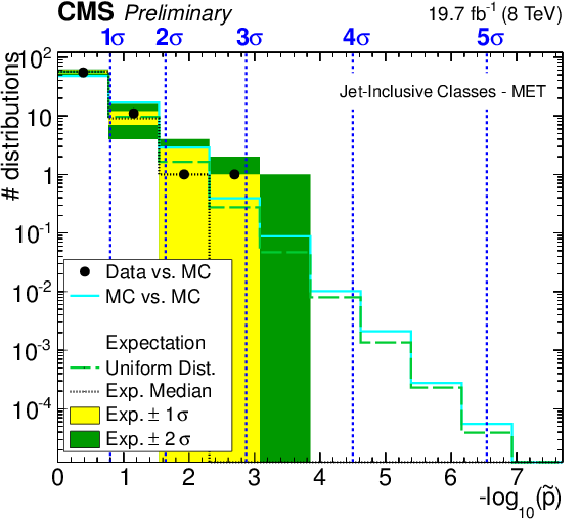
png pdf |
Figure 9-c:
Distribution of $\tilde{p}$-values for a scan of jet-inclusive event classes in the MET variable. Black markers represent the measured data compared to the SM MC expectation. The histogram labeled "MC vs. MC" represents the comparison of the SM MC expectation to pseudo-data generated under the SM-only hypothesis. As a further comparison, the expectation from the uniform distribution is given, where the individual components are explained in Sec. 3.5. Up to 2 10$^{-6}$ pseudo-experiments were generated for each event class, allowing $ \tilde{p} $ values of up to 5$\sigma $ to be assessed. |
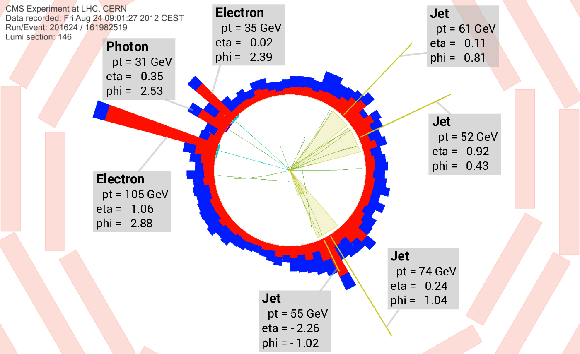
png pdf |
Figure 10:
Event display of the event contributing to event classes 2e + 1$\gamma$ + 4jets (+X / +Njet) in the $\rho $-$\phi $ view of the CMS detector. Red / blue towers indicate deposits in the ECAL / HCAL proportional to the reconstructed energy. MUSiC kinematic variables of this event are ${\sum | \vec{p}_{\mathrm{T}} |} = $ 414 GeV and $ {M} = $ 718 GeV. The missing transverse energy is reconstructed as $MET = $ 27 GeV. |
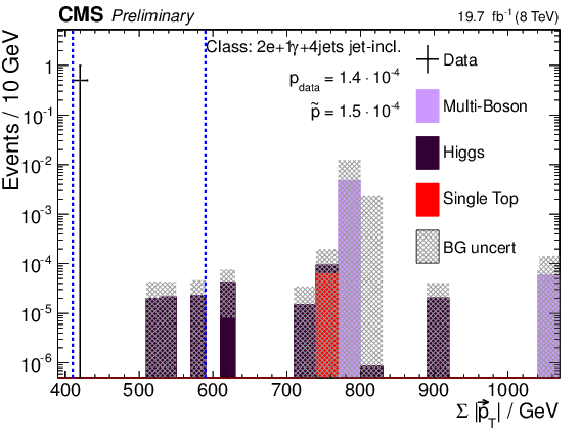
png pdf |
Figure 11:
Distribution of ${\sum | \vec{p}_{\mathrm{T}} |} $ in events with two electrons, one photon and at least four jets. |
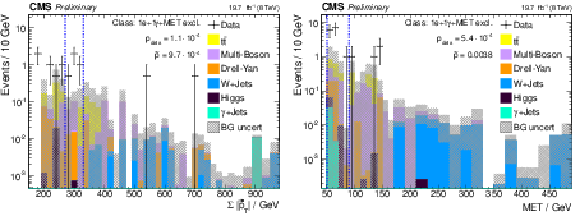
png pdf |
Figure 12:
Distributions of ${\sum | \vec{p}_{\mathrm{T}} |} $ and MET in the exclusive event class 1e+1$\gamma$+MET. |

png pdf |
Figure 12-a:
Distribution of ${\sum | \vec{p}_{\mathrm{T}} |} $ in the exclusive event class 1e+1$\gamma$+MET. |
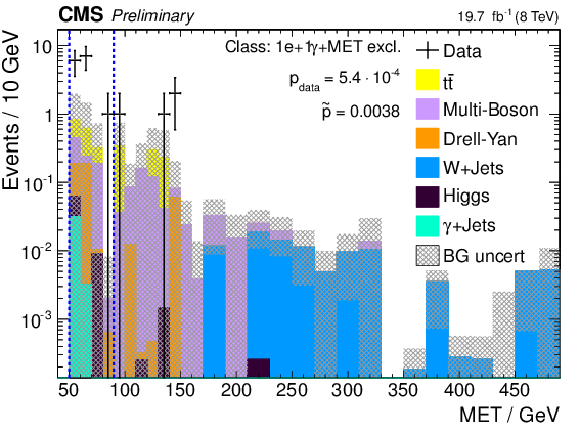
png pdf |
Figure 12-b:
Distributions of MET in the exclusive event class 1e+1$\gamma$+MET. |
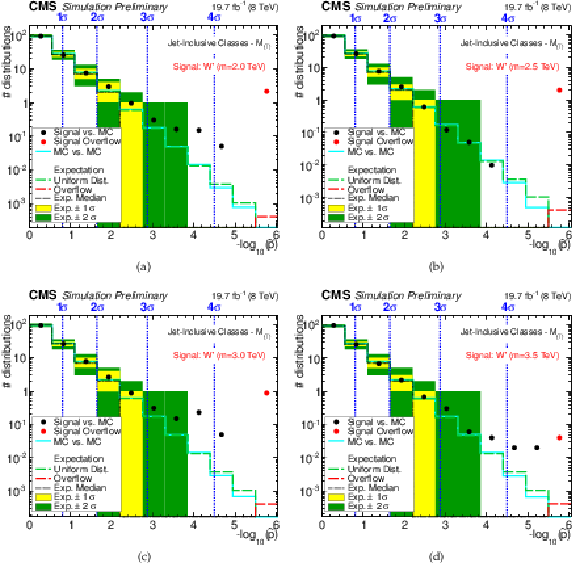
png pdf |
Figure 13:
Distributions of $\tilde{p}$-values for the $ {M_{(T)}} $ distribution of jet-inclusive event classes. Black markers represent the averaged results of pseudo-data from 100 signal dicing rounds in each event class. Four different ${W^{\prime }} $ masses ($m_{ {W^{\prime }} }=$ 2.0, 2.5, 3.0, 3.5 TeV) are considered. |

png pdf |
Figure 13-a:
Distributions of $\tilde{p}$-values for the $ {M_{(T)}} $ distribution of jet-inclusive event classes. Black markers represent the averaged results of pseudo-data from 100 signal dicing rounds in each event class, for ${W^{\prime }} $ mass $m_{ {W^{\prime }} }=$ 2.0 TeV. |

png pdf |
Figure 13-b:
Distributions of $\tilde{p}$-values for the $ {M_{(T)}} $ distribution of jet-inclusive event classes. Black markers represent the averaged results of pseudo-data from 100 signal dicing rounds in each event class, for ${W^{\prime }} $ mass $m_{ {W^{\prime }} }=$ 2.5 TeV. |

png pdf |
Figure 13-c:
Distributions of $\tilde{p}$-values for the $ {M_{(T)}} $ distribution of jet-inclusive event classes. Black markers represent the averaged results of pseudo-data from 100 signal dicing rounds in each event class, for ${W^{\prime }} $ mass $m_{ {W^{\prime }} }=$ 3.0 TeV. |
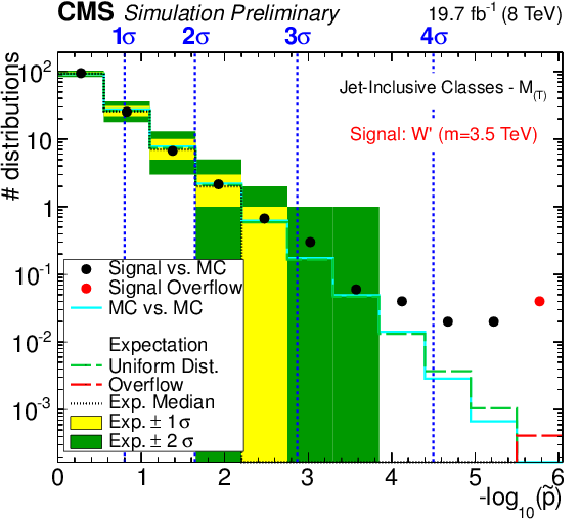
png pdf |
Figure 13-d:
Distributions of $\tilde{p}$-values for the $ {M_{(T)}} $ distribution of jet-inclusive event classes. Black markers represent the averaged results of pseudo-data from 100 signal dicing rounds in each event class, for ${W^{\prime }} $ mass $m_{ {W^{\prime }} }=$ 3.5 TeV. |
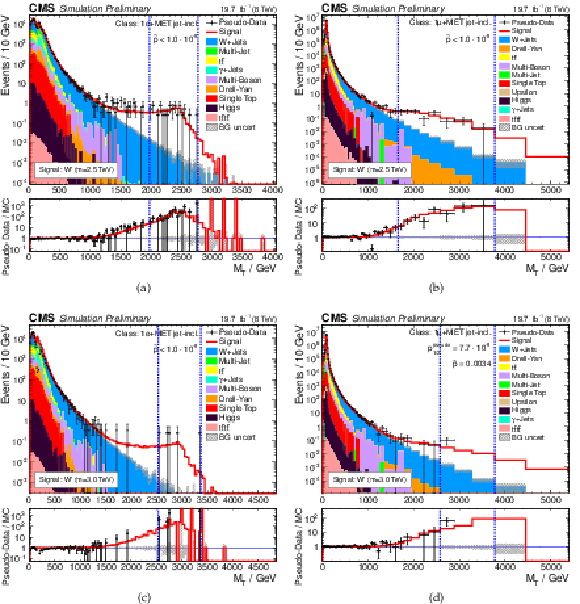
png pdf |
Figure 14:
${M_{T}}$ distributions for the 1e+MET+Njet and 1$\mu$+MET+Njet jet-inclusive event classes. Black markers represent the median result of pseudo-data from 100 signal dicing rounds assuming a ${W^{\prime }}$ scenario with $m_{ {W^{\prime }} }= $ 2.5 TeV (a, b) and $m_{ {W^{\prime }} }=$ 3.0 TeV (c, d). The signal itself is shown by a red line. In a), b) and c) the number of pseudo-experiments is only sufficient to quote an upper limit on the value of $ \tilde{p} $. |
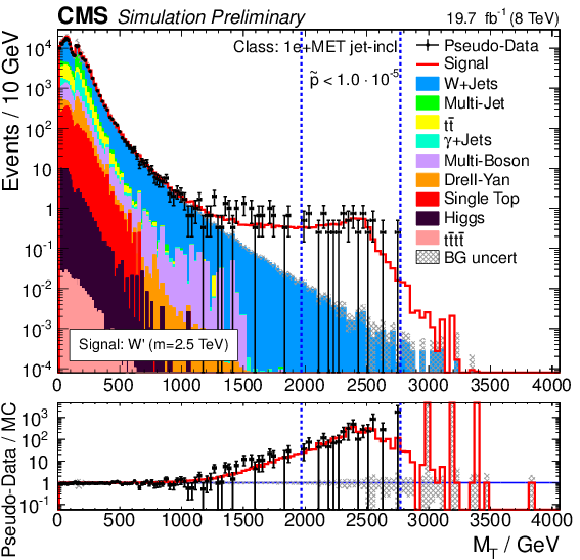
png pdf |
Figure 14-a:
${M_{T}}$ distributions for the |
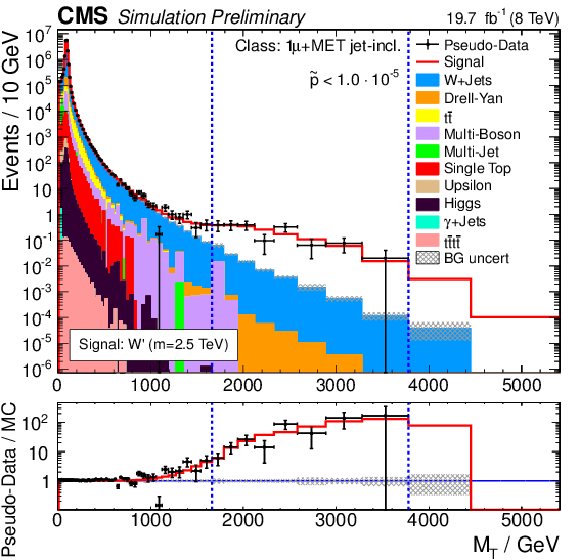
png pdf |
Figure 14-b:
${M_{T}}$ distributions for the 1$\mu$+MET+Njet jet-inclusive event class. Black markers represent the median result of pseudo-data from 100 signal dicing rounds assuming a ${W^{\prime }}$ scenario with $m_{ {W^{\prime }} }= $ 2.5 TeV. The signal itself is shown by a red line. The number of pseudo-experiments is only sufficient to quote an upper limit on the value of $ \tilde{p} $. |

png pdf |
Figure 14-c:
${M_{T}}$ distributions for the1e+MET+Njet jet-inclusive event class. Black markers represent the median result of pseudo-data from 100 signal dicing rounds assuming a ${W^{\prime }}$ scenario with $m_{ {W^{\prime }} }= $ 3.0 TeV. The signal itself is shown by a red line. The number of pseudo-experiments is only sufficient to quote an upper limit on the value of $ \tilde{p} $. |
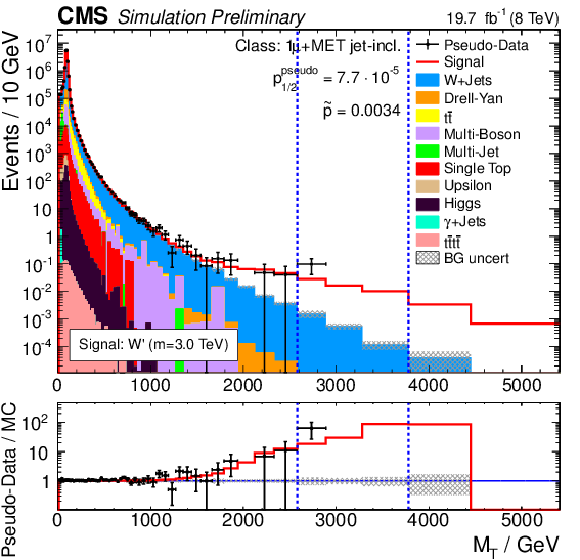
png pdf |
Figure 14-d:
${M_{T}}$ distributions for the 1$\mu$+MET+Njet jet-inclusive event class. Black markers represent the median result of pseudo-data from 100 signal dicing rounds assuming a ${W^{\prime }}$ scenario with $m_{ {W^{\prime }} }= $ 3.0 TeV. The signal itself is shown by a red line. |
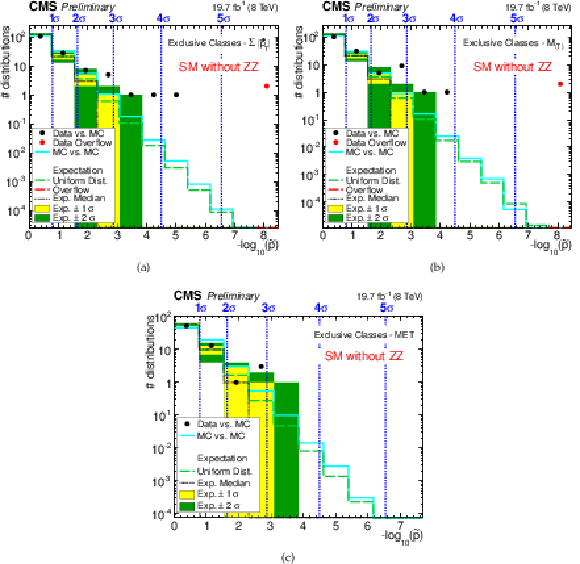
png pdf |
Figure 15:
Distributions of $\tilde{p}$-values for kinematic distributions (a: ${\sum | \vec{p}_{\mathrm{T}} |} $, b: $ {M_{(T)}} $, c:MET) of exclusive event classes. Black markers represent measured data compared to the SM MC expectation from which modeling of ZZ production has been removed. |
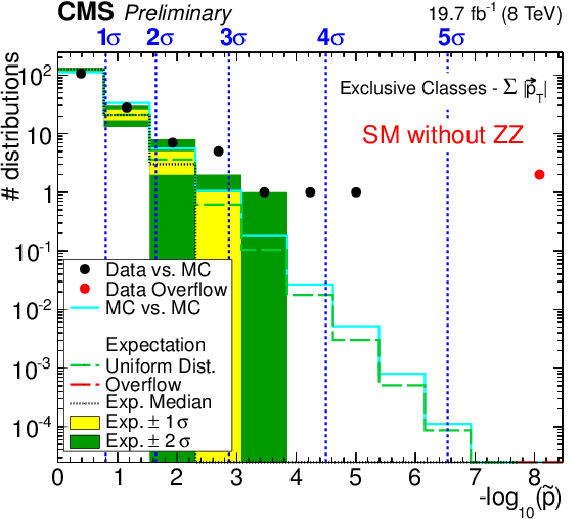
png pdf |
Figure 15-a:
Distribution of $\tilde{p}$-values for ${\sum | \vec{p}_{\mathrm{T}} |} $. Black markers represent measured data compared to the SM MC expectation from which modeling of ZZ production has been removed. |
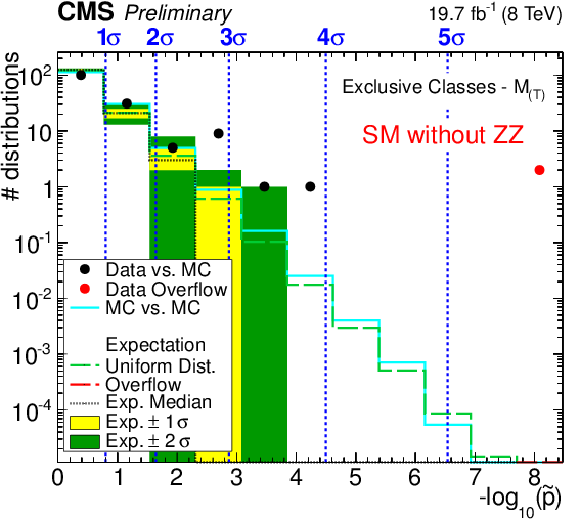
png pdf |
Figure 15-b:
Distribution of $\tilde{p}$-values for $ {M_{(T)}} $. Black markers represent measured data compared to the SM MC expectation from which modeling of ZZ production has been removed. |

png pdf |
Figure 15-c:
Distribution of $\tilde{p}$-values for MET. Black markers represent measured data compared to the SM MC expectation from which modeling of ZZ production has been removed. |
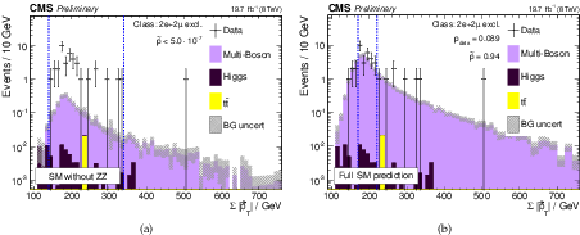
png pdf |
Figure 16:
In a), the ${\sum | \vec{p}_{\mathrm{T}} |} $ distribution for the 2e+2$\mu$ exclusive event class of measured data is compared to a SM MC expectation from which ZZ production has been removed. For comparison, results of the same distribution using the full SM description (including ZZ production) are shown in b). |
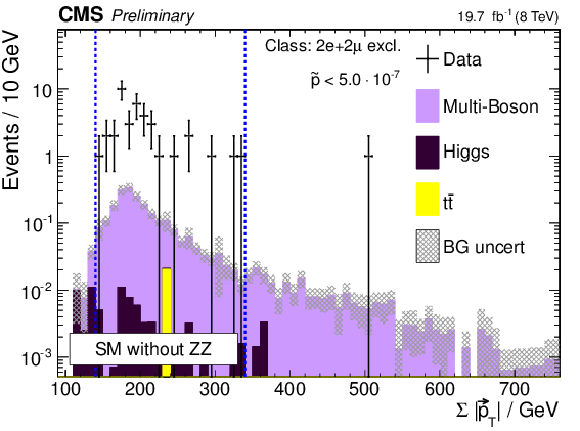
png pdf |
Figure 16-a:
The ${\sum | \vec{p}_{\mathrm{T}} |} $ distribution for the 2e+2$\mu$ exclusive event class of measured data is compared to a SM MC expectation from which ZZ production has been removed. |

png pdf |
Figure 16-b:
For comparisonif FIg.16-a, results of the same distribution using the full SM description (including ZZ production) are shown. |
| Tables | |
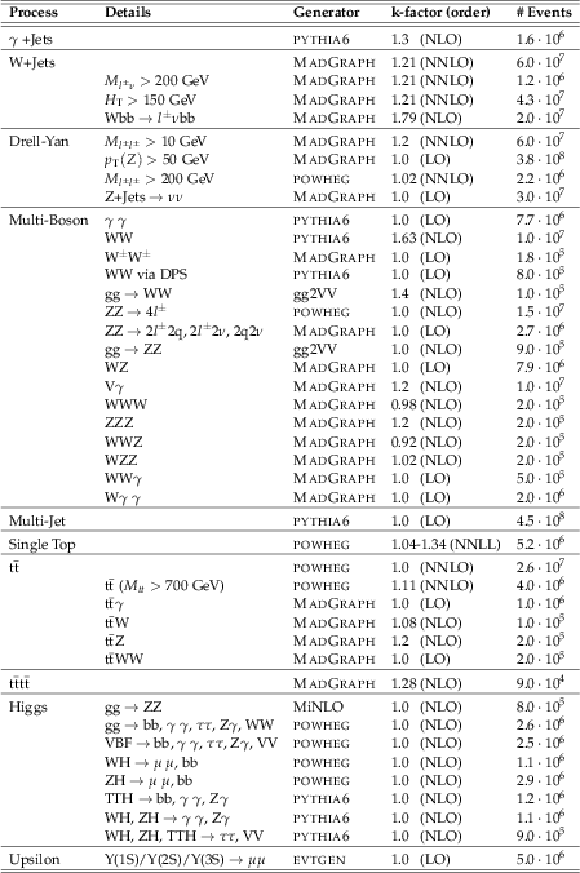
png pdf |
Table 1:
Summary of standard model simulation datasets used in this analysis. |

png pdf |
Table 2:
Details for all distributions of exclusive, inclusive and jet-inclusive event classes containing data where no valid RoI could be found (all regions of distribution were skipped). Total data $N_{\text {Data}}$ and SM $N_{\text {SM}} \pm \sigma _{\text {SM}}$ event yields are given. |

png pdf |
Table 3:
Overview of the two most significant event classes from each scan type. Corresponding significance values are given in each case, where the $p$-value represents the full significance in the scan of total event yield. The $\tilde{p}$-value is stated for scans of kinematic distributions. |
| Summary |
|
In this analysis summary, the implementation and results of the Model Unspecific Search in CMS (MUSiC) performed using data taken by the CMS detector at the LHC with a center of mass energy of 8 TeV were presented. The search was performed with the full 20 fb$^{-1}$ of data collected in 2012. In order to scan the data for deviations from the standard model Monte Carlo simulation, all events were first sorted into event classes depending on the particle content in the final state. Up to three kinematic distributions (${\sum | \vec{p}_{\mathrm{T}} |} $, ${M_{(T)}}$ and if present MET) were analyzed for every event class. In every distribution, an algorithm searched for the region deviating most strongly, the Region of Interest. This was done by calculating a $p$-value for each region in every distribution. For every distribution the $p$-valueof the region of interest was corrected for the Look-Elsewhere Effect, thus taking the large number of scanned regions into account. The algorithm was validated in a number of sensitivity studies. No evidence of new physics was found in the analyzed data, consisting of electron and muon triggered events. For a wide range of final state topologies, good agreement is found between the data and the Monte Carlo based standard model simulation. |
| References | ||||
| 1 | CMS Collaboration | The CMS experiment at the CERN LHC | JINST 3 (2008) S08004 | CMS-00-001 |
| 2 | CMS Collaboration | Model Unspecific Search for New Physics in pp Collisions at $ \sqrt{s} = $ 7 TeV | CDS | |
| 3 | D0 Collaboration | Search for new physics in $ e\mu{}X $ data at D0 using SLEUTH: A quasi-model-independent search strategy for new physics | PRD 62 (2000), no. 9, 092004 | |
| 4 | D0 Collaboration | Quasi-model-independent search for new physics at large transverse momentum | PRD 64 (2001), no. 1, 012004 | |
| 5 | D0 Collaboration | Quasi-Model-Independent Search for New High $ p_{T} $ Physics at D0 | PRL 86 (2001), no. 17, 3712--3717 | |
| 6 | D0 Collaboration | Model independent search for new phenomena in $ p\bar{p} $ collisions at $ \sqrt{s}=$ 1.96 TeV | PRD 85 (2012) 092015 | |
| 7 | H1 Collaboration | A general search for new phenomena in ep scattering at HERA | PLB 602 (2004), no. 1-2, 14 -- 30 | |
| 8 | H1 Collaboration | A General Search for New Phenomena at HERA | Phys. Lett.B 674 (2009) 257--268 | |
| 9 | CDF Collaboration | Model-independent and quasi-model-independent search for new physics at CDF | PRD 78 (2008), no. 1, 012002 | |
| 10 | CDF Collaboration | Global Search for New Physics with 2.0 fb$ ^{-1} $ at CDF | PRD 79 (2009) 011101 | |
| 11 | ATLAS Collaboration | A general search for new phenomena with the ATLAS detector in pp collisions at $ \sqrt{s} = $ 8 TeV | Technical Report ATLAS-CONF-2014-006 | |
| 12 | ATLAS Collaboration | A model independent general search for new phenomena with the ATLAS detector at $ \sqrt{s} = $ 13 TeV | Technical Report ATLAS-CONF-2017-001 | |
| 13 | CMS Collaboration | Particle-Flow Event Reconstruction in CMS and Performance for Jets, Taus, and MET | CDS | |
| 14 | CMS Collaboration | Commissioning of the Particle-flow Event Reconstruction with the first LHC collisions recorded in the CMS detector | CDS | |
| 15 | CMS Collaboration | Performance of CMS muon reconstruction in $ pp $ collision events at $ \sqrt{s} = $ 7 TeV | JINST 7 (2012) P10002 | |
| 16 | M. Cacciari, G. P. Salam, and G. Soyez | The Anti-$ k_T $ jet clustering algorithm | JHEP 0804 (2008) 063 | |
| 17 | CMS Collaboration | Jet energy scale and resolution in the CMS experiment in pp collisions at 8 TeV | JINST 12 (2017), no. 02, P02014 | |
| 18 | R. D. Cousins, J. T. Linnemann, and J. Tucker | Evaluation of three methods for calculating statistical significance when incorporating a systematic uncertainty into a test of the background-only hypothesis for a Poisson process | Nucl. Instr. Meth. Phys. A 595 (2008), no. 2, 480 -- 501 | |
| 19 | J. Alwall et al. | The automated computation of tree-level and next-to-leading order differential cross sections, and their matching to parton shower simulations | JHEP 1407 (2014) 079 | |
| 20 | T. Sjostrand, S. Mrenna, and P. Z. Skands | PYTHIA 6.4 Physics and Manual | JHEP 0605 (2006) 026 | |
| 21 | S. Alioli, P. Nason, C. Oleari, and E. Re | A general framework for implementing NLO calculations in shower Monte Carlo programs: the POWHEG BOX | JHEP 1006 (2010) 043 | |
| 22 | T. Binoth, M. Ciccolini, N. Kauer, and M. Kramer | Gluon-induced W-boson pair production at the LHC | JHEP 0612 (2006) 046 | |
| 23 | T. Binoth, N. Kauer, and P. Mertsch | Gluon-induced QCD corrections to $ pp \rightarrow ZZ \rightarrow l\bar{l} l'\bar{l'} $ | ||
| 24 | D. Lange | The EvtGen particle decay simulation package | NIMA462 (2001) 152--155 | |
| 25 | K. Hamilton, P. Nason, and G. Zanderighi | MINLO: Multi-Scale Improved NLO | JHEP 10 (2012) 155 | |
| 26 | J. Pumplin et al. | New Generation of Parton Distributions with Uncertainties from Global QCD Analysis | JHEP 07 (2002) 012 | |
| 27 | H.-L. Lai et al. | New parton distributions for collider physics | PRD82 (2010) 074024 | |
| 28 | CMS Collaboration | CMS Luminosity Based on Pixel Cluster Counting - Summer 2013 Update | CMS-PAS-LUM-13-001 | CMS-PAS-LUM-13-001 |
| 29 | R. Boughezal, X. Liu, and F. Petriello | W-boson plus jet differential distributions at NNLO in QCD | PRD94 (2016), no. 11, 113009 | |
| 30 | S. Kallweit et al. | NLO QCD+EW predictions for V + jets including off-shell vector-boson decays and multijet merging | JHEP 04 (2016) 021 | |
| 31 | M. Czakon, P. Fiedler, and A. Mitov | Total Top-Quark Pair-Production Cross Section at Hadron Colliders Through $ \mathcal{O}({\alpha{}}_{S}^{4}) $ | PRL 110 (2013) 252004 | |
| 32 | S. Alekhin et al. | The PDF4LHC Working Group Interim Report | technical report | 1101.0536 |
| 33 | CMS Collaboration | Determination of jet energy calibration and transverse momentum resolution in CMS | JINST 6 (2011) 11002 | |
| 34 | CMS Collaboration | Search for physics beyond the standard model in dilepton mass spectra in proton-proton collisions at $ \sqrt{s} = $ 8 TeV | JHEP 04 (2015) 025 | |
| 35 | G. Altarelli, B. Mele, and M. Ruiz-Altaba | Searching for new heavy vector bosons in p$ \bar{\text{p}} $ colliders | Z. Phys. C Particles and Fields 45 (1989) 109 | |
| 36 | CMS Collaboration | Search for physics beyond the standard model in final states with a lepton and missing transverse energy in proton-proton collisions at $ \sqrt{s} = $ 8 TeV | PRD 91 (2015) 092005 | |

|
Compact Muon Solenoid LHC, CERN |

|

|

|

|

|

|